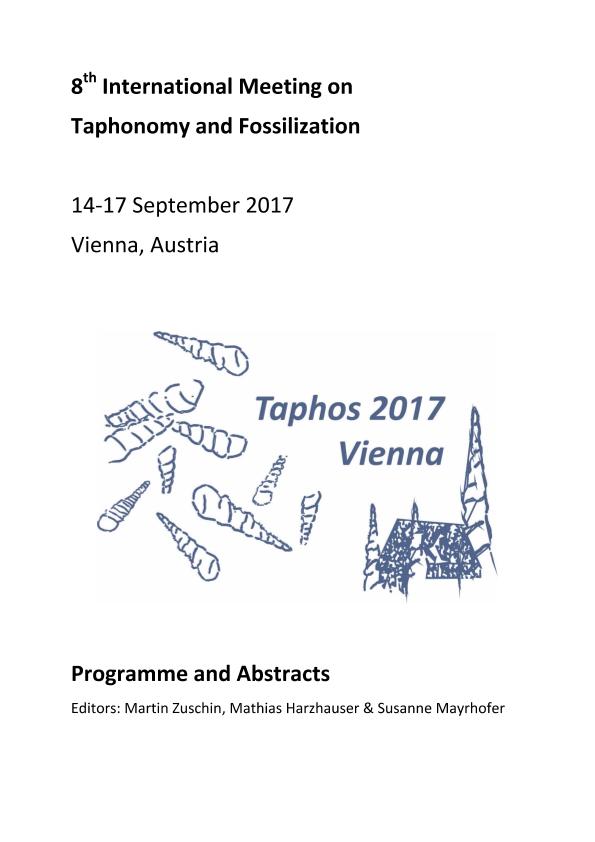Mostrar el registro sencillo del ítem
dc.contributor.author
Lehmann, Oscar Emilio Rodrigo

dc.contributor.author
Velan, Osvaldo
dc.contributor.author
Lazo, Dario Gustavo

dc.date.available
2024-03-05T15:39:26Z
dc.date.issued
2017
dc.identifier.citation
CT scanning as a tool for taphonomic analysis of shell beds: a case study on small irregular echinoid concretionary accumulations from the upper Hauterivian of the Neuquén Basin, west-central Argentina; 8th International Meeting on Taphonomy and Fossilization; Austria; 2017; 72-73
dc.identifier.uri
http://hdl.handle.net/11336/229411
dc.description.abstract
Over the last two decades 3D-imaging techniques have been widely used in the reconstruction of fossils, from skulls and bones to the microstructure of delicate carbonized flowers. In general, shell beds lie outside the feasible size range in which these methods provide meaningful data. If a fossil concentration could be studied this way, important information could be easily assessed or quantified. For example, the close-packing of bioclasts and size-sorting could be assessed easily. Also, the percentage in volume of bioclasts relative to the sedimentary matrix and the amount of individuals per volume unit could be calculated in few steps. Here we present a case study using small irregular echinoid concretionary accumulations from the Agrio Formation, upper Hauterivian, Neuquén Basin, west-central Argentina.The studied carbonate concretions (N= 9) were collected from a single bed in the upper third of the Agua de la Mula Member. They contain a monotypic accumulation of small irregular echinoids belonging to the genus Caenholectypus POMEL immersed in a fine-grained matrix. The concretions are ellipsoidal and range in size from 6 to 15cm in length and 4.5-5.5 cm in thickness.Four concretions (Fig. 1A) were selected to be scanned with a Toshiba Aquilion ONE medical CT scanner, with 120kV, 500mA and a final slide thickness of 0.5mm at the Instituto Universitario Hospital Italiano of Buenos Aires. This resulted in an image stack of 1267 slides that was further digitally processed.First the density of individuals was estimated using between five and seven 1cm-sided randomly located cubes inside each concretion (Fig. 1B). The number of individuals with at least 50% of volume included in each cube was counted. This number was divided by the volume of the cube, obtaining its density. The mean of all the cubes? densities was used to estimate the density of the whole concentration, which resulted in 4.23 echinoids/cm3. A digital simulation of an ellipsoid with the dimensions of the concretions filled with smaller ellipsoids with the size of the echinoids produced very similar visual results as those observed in the CTs. This was used as a confirmation for the previous result.Then, the close-packing of bioclasts was observed across each concretion in two perpendicular directions (Fig. 1C). Following the usual classification, the studied accumulation is densely to loosely packed, with some exceptional patches where it could be described as loosely packed (matrix-supported). This was done considering the nearly hemispherical shape of the echinoids. Finally, the percentage of bioclasts relative to the sedimentary matrix was estimated in two ways. Firstly, the previously obtained density of individuals and their approximate volume were used in conjunction with the volume of the concretions. This approach resulted in an estimated percentage of 56.77%. This value matches closely the lower boundary of the ?dense/loose? close-packing category (55%) included in traditional visual guides. The second way was to use the volume of the73concretions and the volume of the echinoids after digitally removing the sediment. This method yielded widely varying results, from 30.15% to 47.95%.The disagreement between these results may be due to an ineffective removal of the sediment from the 3D-images. Some echinoids are filled with the same matrix that surrounds them, while others are devoid of it and cemented internally. This situation complicates the differentiation between the echinoids and the matrix based solely on density, as many digital tools do. However, the echinoids remain visually distinct throughout the concretions.The previous results are being used to aid the interpretation of the genetic origin of the echinoid accumulation, as well as a quantification of the basic descriptive taphonomic information. Remarkably, these results were accomplished without the destruction of the concretions and preserving the echinoids for further studies.
dc.format
application/pdf
dc.language.iso
eng
dc.publisher
University of Wien
dc.rights
info:eu-repo/semantics/openAccess
dc.rights.uri
https://creativecommons.org/licenses/by-nc-sa/2.5/ar/
dc.subject
Echinoid
dc.subject
Taphonomy
dc.subject
Concretion
dc.subject
C-T scan
dc.subject.classification
Paleontología

dc.subject.classification
Ciencias de la Tierra y relacionadas con el Medio Ambiente

dc.subject.classification
CIENCIAS NATURALES Y EXACTAS

dc.title
CT scanning as a tool for taphonomic analysis of shell beds: a case study on small irregular echinoid concretionary accumulations from the upper Hauterivian of the Neuquén Basin, west-central Argentina
dc.type
info:eu-repo/semantics/publishedVersion
dc.type
info:eu-repo/semantics/conferenceObject
dc.type
info:ar-repo/semantics/documento de conferencia
dc.date.updated
2024-02-28T14:00:57Z
dc.journal.pagination
72-73
dc.journal.pais
Austria

dc.journal.ciudad
Wien
dc.description.fil
Fil: Lehmann, Oscar Emilio Rodrigo. Consejo Nacional de Investigaciones Científicas y Técnicas. Oficina de Coordinación Administrativa Ciudad Universitaria. Instituto de Estudios Andinos "Don Pablo Groeber". Universidad de Buenos Aires. Facultad de Ciencias Exactas y Naturales. Instituto de Estudios Andinos "Don Pablo Groeber"; Argentina. Universidad de Buenos Aires. Facultad de Ciencias Exactas y Naturales. Departamento de Geología; Argentina
dc.description.fil
Fil: Velan, Osvaldo. Hospital Italiano; Argentina
dc.description.fil
Fil: Lazo, Dario Gustavo. Consejo Nacional de Investigaciones Científicas y Técnicas. Oficina de Coordinación Administrativa Ciudad Universitaria. Instituto de Estudios Andinos "Don Pablo Groeber". Universidad de Buenos Aires. Facultad de Ciencias Exactas y Naturales. Instituto de Estudios Andinos "Don Pablo Groeber"; Argentina. Universidad de Buenos Aires. Facultad de Ciencias Exactas y Naturales. Departamento de Geología; Argentina
dc.relation.alternativeid
info:eu-repo/semantics/altIdentifier/url/https://taphos2017.univie.ac.at/home/
dc.relation.alternativeid
info:eu-repo/semantics/altIdentifier/url/https://taphos2017.univie.ac.at/fileadmin/user_upload/k_taphos2017/Programme_and_Abstracts_-Taphos_2017.pdf
dc.conicet.rol
Autor

dc.conicet.rol
Autor

dc.conicet.rol
Autor

dc.coverage
Internacional
dc.type.subtype
Reunión
dc.description.nombreEvento
8th International Meeting on Taphonomy and Fossilization
dc.date.evento
2017-09-14
dc.description.paisEvento
Austria

dc.type.publicacion
Book
dc.description.institucionOrganizadora
University of Vienna
dc.description.institucionOrganizadora
Natural History Museum Vienna
dc.source.libro
8th International Meeting on Taphonomy and Fossilization
dc.date.eventoHasta
2017-09-17
dc.type
Reunión
Archivos asociados
